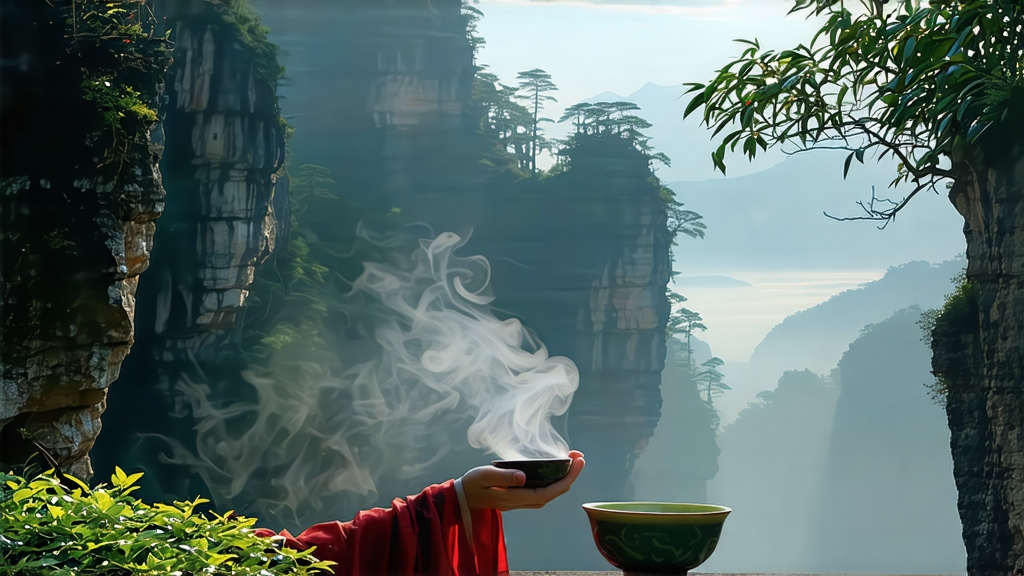
If green tea is China’s springtime and pu-erh its autumn, then oolong is the country’s long, golden afternoon—balanced between freshness and depth, floral lift and mineral bass. Among the hundreds of oolongs that arc across the southern provinces, none carries more myth, more geological memory, or more courtly prestige than Da Hong Pao, literally “Big Red Robe,” from the Wuyi Mountains of northern Fujian. To drink it is to taste granite cliffs, Song-dynasty monks, and the smoke of ten consecutive charcoal fires, all within a single sip.
A legend for the palate
The name first appears in Ming-era gazetteers, but the story every local guide loves to tell happened during the late Ming dynasty. A scholar was hurrying to the capital for the imperial exam when he fell ill on the arduous mountain pass. A monk from the Wuyi Tianxin Temple brewed a dark, amber liquor from leaves he had picked on the cliff opposite the temple. The scholar revived, continued north, placed first in the exam, and returned in scarlet official robes to thank the monk. He draped his robe over the four mother bushes that had supplied the tea, declaring, “Your leaves clothed me in honor; now my robe clothes you in glory.” Whether apocryphal or not, the tale fixed the tea’s identity: imperial, medicinal, and inseparable from the vertiginous rock face known as Jiulong Ke, “Nine-Dragon Gorge.”
Terroir that bites back
The Wuyi range is a 550-million-year-old slice of submarine sediment thrust upward and baked by granitic intrusions. Its narrow gorges trap humid air from the nearby Jinjiang River, creating a perpetual mist that filters sunlight into a soft, shifting lantern. The soil is a stony conglomerate called “rock crumb”—thin, fast-draining, and laced with quartz and feldspar. Vines and tea bushes must plunge roots directly into fissures, absorbing minerals that later translate into the celebrated yan yun, “rock rhyme,” a mouth-watering, iodine-tinged finish that lingers like the echo of a struck bell. Only tea grown within the 60-square-kilometer core scenic zone may legally be sold as Zheng Yan, “true cliff,” Da Hong Pao; outside that boundary the same cultivars yield merely “half-cliff” or “riverside” tea, pleasant but lacking the bass-note minerality.
Cultivars: a quartet in one robe
Modern Da Hong Pao is not a single plant but a carefully orchestrated blend of four traditional Wuyi cultivars, each contributing a voice to the chorus:
- Qi Dan – the original “strange red,” a low-yield, small-leaf variety that supplies the core floral honey note.
- Bei Dou – “North Star,” prized for its cold resistance and bright apricot aroma.
- Que She – “Sparrow Tongue,” whose tiny leaves add high-pitched orchid fragrance.
- Tie Luo Han – “Iron Arhat,” the most mineral-driven, lending the structure that ages gracefully.
By law any blend labeled “mother-tree Da Hong Pao” must contain at least 30 % genetic material traced to the 350-year-old mother bushes still clinging to the cliff. Since 2006 picking from those venerable plants has been banned to protect them; what remains in circulation are leaf-to-leaf grafted descendants or the 20 grams of 1998 harvest locked inside the China National Tea Museum vault—valued at roughly US $30,000 for that single ounce.
Craft: the nine gates of fire
The making of Da Hong Pao spans 18 months and nine discrete firings, a schedule that would exhaust most other teas. The sequence begins in early May, just before the Grain Rain, when two leaves and a bud are plucked at dawn while the dew still holds the gorge’s chill. Wilting occurs on bamboo trays set inside the cave-mouths of old kilns, where temperature and humidity hover like a held breath. Once the leaf edges soften and emit a faint apple-skin aroma, workers toss the leaves in 1.2-meter-deep wicker drums, bruising the margins just enough to coax oxidation enzymes from their cellular chambers. Oxidation is arrested at roughly 40 %—the midpoint that gives oolong its bi-polar character—by a 280 °C tumble in cast-